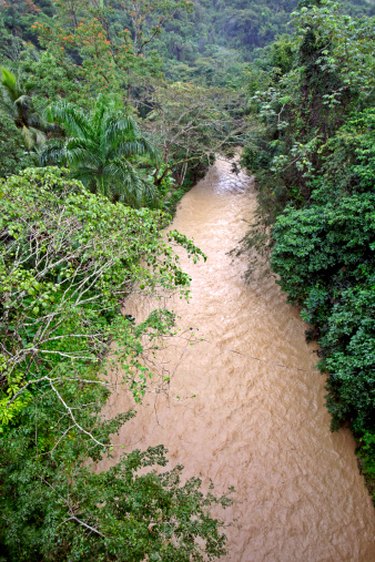
Brazil is the largest country in South America and the fifth largest country in the world. Its diverse geography features mountains, highlands and plains. It has a complex system of rivers--the largest being the Amazon river. Most of the country is tropical and includes coniferous forests and tropical rain forests. Much of the Amazon rain forest is located within the borders of Brazil. Brazil has many native plants, including flowers, trees and nuts.
Flowers
Video of the Day
There are over 22,000 flowering plants native to Brazil. The tropical climate is ideal for producing exotic, fragrant blooms with brilliant colors. One of the most delicate flower species of Brazil is the orchid, from the family Orchidaceae. There are over 2,500 orchid species commonly found growing on large trees and in the rain-forest canopy. Brazil is also known for being home to several rare flowers, some of which horticulturists dedicate their lives to finding. The Amazonian water lily and blue-flowering Griffinia are both rare and endangered. Several species of hibiscus, jasmine, freesia, trumpet flowers, begonias and gloxinia also call this country home.
Video of the Day
Fruits
Brazil has no shortage of native fruit plants and trees. In fact, the city of Rio, Brazil, is well-known for its fresh-fruit juice bars. One of the most popular fruits from Brazil is acai, a fruit from a species of palm. The acai fruit is noted for containing several vitamins and antioxidants. The pitanga fruit is a tiny fruit of the pitangueira tree, which is grown throughout Brazil. Pineapple, passion fruit, mango and papaya are all fruits native to Brazil, although they grow in other countries as well. The coconut palm grows throughout Brazil and is valued for its coconut fruit. Lemon and lime trees produce fragrant citrus fruits. Several species of guava fruit are grown throughout the tropics of Brazil.
Nuts and Seeds
The tropical climate of Brazil is ideal for growing a number of edible seeds and nuts. Perhaps the most well-known nut from this country is the Brazil nut. The nut is grown on the Brazil nut tree, Bertholletia Excelsa, which can reach heights of 200 feet in the Amazon rain-forest canopy. The fleshy nut is protected by a thick, brown seed coat. The sapucaia tree, a member of the myrtle family, produces nuts similar to the Brazil nut. In the United States, the sapucaia nuts are commonly called Paradise Nuts. The cashew tree is native to northeastern Brazil and is well known for producing cashew nuts and cashew apples. Theobroma cacao, also known as the cocoa tree, is indigenous to the tropical regions of South America, including Brazil. Its fruit pods are harvested and the seeds are used to create chocolate.